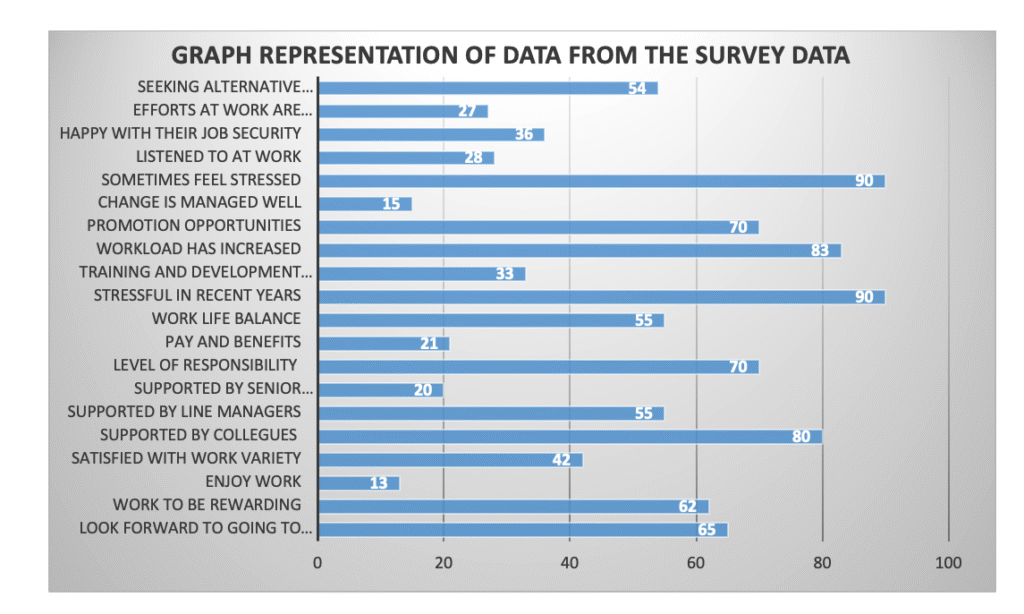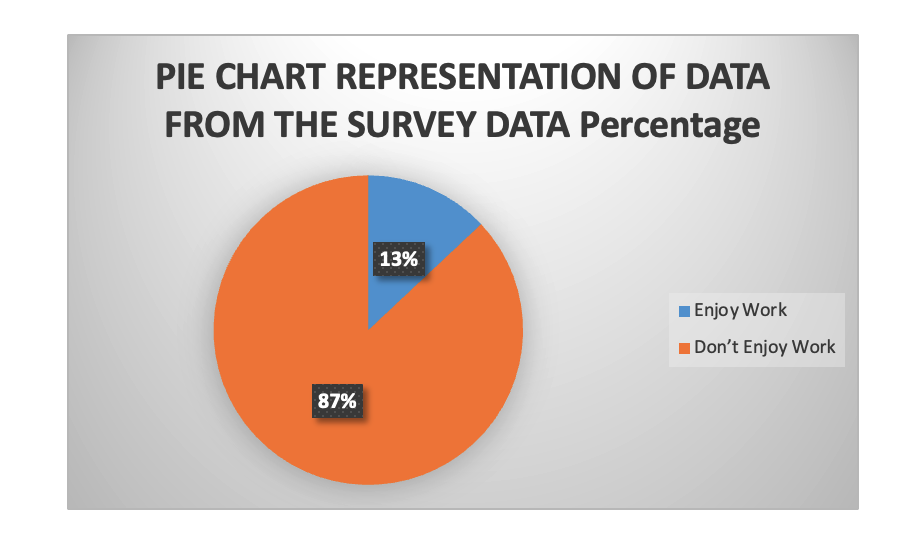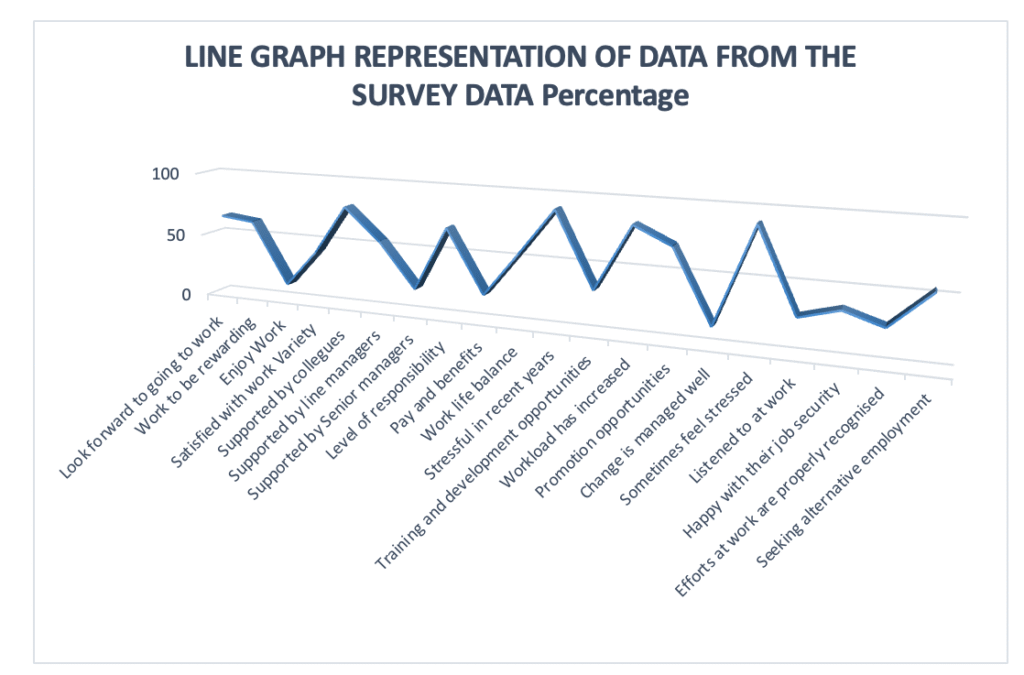Using the data attached on the outcomes of a recent staff survey*, which indicates the level of job satisfaction and motivation, analyse the data and present it visually using three different formats with an explanatory note on what the data shows.
The staffing survey findings conducted by the HR Officer of Old Bridge District Council will be summarised in this section. The survey was conducted to establish levels of satisfaction and engagement among staff. A confidential questionnaire was designed, and 75% of staff responded. Results were summarised in the table below.
| Variable | Percentage |
| Look forward to going to work | 65 |
| Work to be rewarding | 62 |
| Enjoy Work | 13 |
| Satisfied with work Variety | 42 |
| Supported by colleagues | 80 |
| Supported by line managers | 55 |
| Supported by Senior managers | 20 |
| Level of responsibility | 70 |
| Pay and benefits | 21 |
| Work-life balance | 55 |
| Stressful in recent years | 90 |
| Training and development opportunities | 33 |
| Workload has increased | 83 |
| Promotion opportunities | 70 |
| Change is managed well | 15 |
| Sometimes feel stressed | 90 |
| Listened to at work | 28 |
| Happy with their job security | 36 |
| Efforts at work are properly recognised | 27 |
| Seeking alternative employment | 54 |
Graph representation.
The graph below is a visual representation of the information collected and analysed from the questionnaire. 90% of employees reported high-stress levels in recent years at the workplace. Over 50% of the interviewed participants are actively seeking alternative employment. This means that HR should seek solutions for the workplace’s stress and come up with alternative options for employee retention. The graph is an easy to read tool for data representation and analysis.

Pie Chart Representation

Pie charts are a helpful data representation approach that enables the person analysing the data to categorise information based on the size of a component in relation to the total. Pie-charts are good visual representations that show proportions in relation to the total. For example, based on the data provided above, the chart has allocated the smallest proportion to a blue area where only 13% of respondents said they enjoyed their work. 87% did not enjoy their current work position.
Line Graphs

Unlike bar graphs, line graphs present information in a linear form. The percentile is represented on the X-axis and the variables on the Y-axis. The variables, in this case, are many; it may be challenging to ascertain the exact percentile. Line graphs are effective for visual analysis of the general flow or pattern of data.
Set out briefly the different ways in which an organisation might collect and record HR data
During restructuring and redeployment of employees, various factors should be considered, among them being HR data collection and recording. Data collection in an organisation can be achieved by the use of CVs, resumes or application forms. These documents provide adequate information on the qualifications of various employees. Data can be recorded in the form of personal manual files or in a computerised system where it can be easily accessed.
Two reasons why it is necessary for any organisation to collect and record HR data
According to Martin and Whiting (2016), there are about seven reasons why organisations need to collect and record HR data. In the context of restructuring and redeployment, organisations should collect and record data for the following two reasons.
For compliance with legal requirements. There is a statutory requirement that mandate organisations collect, record and keep HR data. For example, HR collects and keeps records of individual work hours in compliance with the working time regulation 1998. The records are essential for monitoring the employees’ welfare in terms of off days and overtime compensation. Payment and compensation records are also kept in compliance with the minimum wage Act and the National Living Wage Act (2016). In the UK, the data is also vital for checking an employee’s eligibility to work, ensuring the grievance and disciplinary processes are adhered to, and overall compliance with all statutory laws and governing bodies such as FCA.
To provide evidence in case of claims against the organisation. Records of daily work attendance and absenteeism, pay, disciplinary procedures, emails exchange between employer and employee, agreements and policies and procedures are essential for all organisations. In case of deployment, an employee may file a claim with the employment tribunal. However, records of agreements and other information may be provided to the court to justify the redeployment action. Redeployment and restructuring of the workforce are commonly done on the basis of performance, and records are essential for justification of the process.
Give a short explanation of how different types of organisational data collected can support HR practice and the management team when restructuring the organisation and redeploying personnel.
Work attendance and absenteeism data. This data helps identify individual employee performance by ensuring that the employees are consistently attending to their duties. According to the IES (2019) report, records of work attendance and absenteeism can be used to establish an employee’s ability or fitness to continue working in the organisation. This data can be useful in the HR practice of redeployment and team management to group employees in different teams based on their performance. The data also provides information on performance; thus, it is critical for the redeployment decision making process.
Turn-over and Recruitment Data. This data is essential for the identification of employee turnover patterns. In terms of restructuring and redeploying, HR can assess the departments experiencing high turnover rates and redeploy the employees. Alternatively, the recruitment structure for those departments can be restructured so as to deal with the underlying issues that cause high turnover rates. Recruitment data is also crucial for monitoring equality and diversity as well as compliance with recruitment policy in an organisation.
- Describe the systems used for recording the data from two of the types of data identified
Work attendance and absenteeism data are recorded in computerised personnel information Systems (CPIS). The system utilises computer software to manage individual information of the workforce. The primary advantage of using CPIS is that it fast, easily accessible, and utilises a small space for recording large volumes of data (Turtenwald, 2019). The disadvantages of using the CPIS system are the risk of data loss in case of a system failure. Information can also be stolen or altered by hackers or malicious individuals if the system is not well secured. The computerised system recording attendance may be in the form of a computerised hand punch system or a clocking system that records the time one goes to work and leaves work.
Two methods of data storage. What are the benefits of using these storage systems?
Electronic data storage method. All data is collected and stored electronically through the use of computers. The HR uses a computerised system to document all employees’ details as well as to analyse the information and compile reports. A computerised system has many benefits to an organisation. The computerised system is efficient, stores a lot of information using a small space, can be easily accessed, and changed information. The electronic system’s challenge is that data can easily be lost if there is no backup, or personal information can be leaked if the HR is not careful.
Another method that the organisations can use is the manual or the traditional data storage method. This method involves recording information on paper and keeping individual files for each employee. CVs, resumes and personal records are mostly presented in hard copies during interview. The personal information should be well preserved for future referencing. The primary advantage of using this method is that it may be more accurate and there are no technical issues that can occur. However, these methods are slow and paper files require a lot of space for storage.
- Explain two legal requirements that any organisation must take into account when recording, storing and accessing HR data.
Principles of Data Protection Act and GDPR (2018). This legislation controls the use of personal information by the organisation and the government. There are eight primary principles guiding this legislation. To begin with, the legislation requires that all the collected information be processed fairly and lawfully. The person using the data must keep it safe, and they should only keep it for a specified period or for as long as they are using it. Personal data should be used only for the reason it was requested, and unlawful processing of personal data may attract penalties. As stipulated in the Data Protection Act, these strict rules should always be adhered to for an organisation to be compliant.
The freedom of information act 2000 gives organisations the right to request information from employees or access information from any public organisation with records. It also accords organisations the right to access any recorded information on any subject by any public sector organisation. For example, an employee may request to access their data as recorded by an organisation.
- Set out your analysis and explanations of the employee engagement survey data.
The levels of satisfaction and engagement are low. This is because half of the existing workforce is actively looking for alternative jobs. Additionally, 25% of the total study population did not want to engage in the survey for various reasons. 18,750 is a relatively big number for a workforce that did not want to be associated with the survey. Of the 56,260 people that participated in the survey, only 36 % were happy with their jobs. High percentiles are recorded for stress-associated issues.
The restructuring and redeployment will be seen as a positive element for the organisation. While half of the existing workforce are considering new jobs, redeploying them to new departments or restructuring their current departments may be motivating and beneficial to the organisation. The HR is likely to encounter minimal resistance to the changes that they are about to implement.
- From your analysis, develop three possible recommendations, explaining why you feel these would help your management team when restructuring the organisation.
Based on the research findings, the rates of staff satisfaction are low compared to the same staff’s stress levels. I would therefore recommend that HR undertakes to restructure as soon as possible. Additionally, I would recommend that the communication system between employees and members of senior management be enhanced. This will make the staff feel more accepted and appreciated by the management. HR should also enlighten employees on the benefits of different roles and responsibilities. Brainstorming sessions between the management and the workers should be held with an aim of enhancing organisational efficiency and performance.
References
CIPD. 2020. Data Protection and GDPR in the Workplace | Factsheets | CIPD. [online] Available at: https://www.cipd.co.uk/knowledge/fundamentals/emp-law/data-protection/factsheet#30043 [Accessed 29 Mar 2021].
Martin, M., & Whiting, F. (2016). Human resource practice. Kogan Page Publishers.
Turtenwald, K., (2019). Advantages & Disadvantages of Traditional File Organization. [online] Career Trend. Available at: https://careertrend.com/info-8637974-advantages-disadvantages-traditional-file-organization.html [Accessed 29 March 2021].
Archive.acas.org.uk. 2020. GDPR – The General Data Protection Regulation | Acas. [online] Available at: https://archive.acas.org.uk/index.aspx?articleid=3717#information [Accessed 29 Mar 2021].
Campus.avadolearning.com. 2020. 3RAI. [online] Available at: https://campus.avadolearning.com/course/view.php?id=4197 [Accessed 29 Mar 2021].
Ico.org.uk. 2020. Guide to the General Data Protection Regulation (GDPR). [online] Available at: https://ico.org.uk/for-organisations/guide-to-data-protection/guide-to-the-general-data-protection-regulation-gdpr/ [Accessed 29 Mar 2021].
Leather Charles, Fletcher Janet & Currie Donald Introduction to Human Resource Management- a Guide to HR in Practice2nd Edition London, CIPD Publications